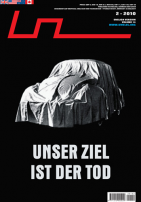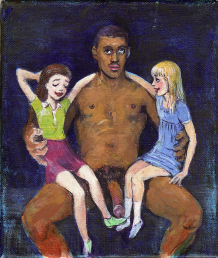| Umělec magazine 2010/2 >> Aesthetic Qualities of Decline | List of all editions. | ||||||||||||
|
|||||||||||||
Aesthetic Qualities of DeclineUmělec magazine 2010/201.02.2010 Donna Howard | The End of the Western Concept | en cs de ru |
|||||||||||||
|
The Bohemian National Hall of New York’s Upper East Side was recently the forum for an Umělec event based on the premise that the ‘Western Concept’ was at its end. The event brought about an array of intriguing ideas as to what it actually meant to partake of this so-called ‘Western Concept’ to begin with, and underlined the relevance of those contemporary artists who seem to be re-evaluating their place with regard to it. This ‘Western Concept’ is considered by Will Lunn and Vishal Sumarria, co-directors of London-based gallery Sumarria Lunn, as an exercise in pure conceptualism, overwhelming and undermining the artist’s skill and integrity. As such, the gallery pride themselves on representing artists who demonstrate a certain “validity” in their work; a move away from this conceptual approach and toward one much more traditional in tone and method.
Eugene Wood, Ross Jones, and Yun-Kyung Jeong are three artists from the gallery who appear to tap into this ambiguous artistic position, where the future of their work seems enticingly undefined, yet inextricably married to the history of their medium. Eugene Wood’s mastery of oil painting is deceptive. The artist is a graduate of the prestigious Institut Supérieur de peinture Van der Kelen-Logelain in Brussels which specialises in this traditional style of painting but, ironically, his works often look like they are not painted at all–appearing more like glycerin prints, or laminated canvas. However, this is precisely why it works; the fusion of contemporary and abstracted subject matter with traditional technique results in a jarring reception on the part of the viewer. We expect to see the strokes, the paint, the work, but instead the marks are hidden, invested so much within his pieces that the paint almost seems to deny itself. In the wake of Greenbergian Modernism we are accustomed to the idea that paint on canvas should look like paint on canvas, its illusory qualities stripped back, yet here we see something quite different. In adopting what is almost a flattening of the paint, Wood denies us one of the fundamentals of the media, its texture. In so doing, we are challenged to look at his work in order to decipher both its process, and its ideas. Whilst proudly admitting his subjects are often mundane (his Isolated Resignation (2008) is essentially a close-up of a degraded yellow road-marking, the visceral ‘cut’ at its end indicating Woods’ frustration at the number of parking tickets he was getting for pausing to look at them) the act of contemplation elevates the commonplace to the intriguing, and in so doing playfully unites the subject with the traditional prestige of its medium. Here Woods plays with art history, and its layered and conflicting ideologies of value. Another artist whose medium may not appear immediately obvious is Ross Jones, whose pencil works are so painstakingly crafted one could easily confuse them with digitised architectural plans. Distilling contemporary socio-political concerns into individual monochromatic images, Jones works to remove the chaos with which we are faced on a daily basis by the media. The clusters of abandoned tents, iron shelters, or —in the case of Affordable Housing (2008)—regimented tower blocks, have a sense of the iconic, situated in space and arranged with a hint of patterning they convey an underlying idea of meditative order. And yet despite the unsettling feeling that there is a complete lack of human presence, Jones’ pieces are never wholly futile; the sense that there is always something, or someone, in the corner of our eye which always manages to escape our gaze is the very thing that prevents Jones from plunging into a damning critique of contemporary politics, instead allowing for a calm and reserved reflection of our contemporary climate. In demonstrating such overall restraint, all the while working in layers of subtle irony, pencil becomes the only medium suitable for such work. By its very nature the pencil allows for erasure and revision, connoting studies, quick sketches, a trying-out of ideas and an opportunity to disregard them in favour of something more refined. In so doing, Jones would seem to almost re-appropriate a Modernist struggle to establish new rules, distinctly different from the past but not as yet certain enough to be captured in a medium of any permanence. However, in the complete lack of visible erasures, Jones paradoxically asserts confidence in constructing perfect pencil structures, and yet by situating them in the vanishing point and refusing the use of a more permanent medium, he leaves us with a sense of uncertainty. This can be interpreted as modesty, an admission that the artist cannot know all. The work of Yun-Kyung Jeong appears, therefore, a welcome antidote to the ennui of the real world interpreted by Jones and Wood. A graduate of the Slade, Jeong offers a utopian retreat from the mundane and the commonplace by way of the Eastern concept of Gyeong (景). As we might expect, difficulties ensue when attempting to translate this into its Western equivalent, but Jeong’s emphasis on a symbiotic co-existence of conflicting opposites appears to undo the control structures that seem so intrinsic to Western art. These conflicts are united through the use of a painted leaf-shaped motif whose recurring deployment forges across the negative space of the canvas to invest it with a life and energy that continues to grow increasingly significant to the artist personally, and reflect her own “burning desire to create something new.” Rather than making manifest these abstract ideas in a similarly abstract fashion, Jeong imposes order by building alluring Utopian landscapes whose construction through her motif’s repetition recalls Jones’ isolated tower blocks. Her careful painting of the leaf’s exact replica time and time again to build up a composition, in another example of an inversion of the values of Greenbergian Modernism, intentionally defies the traditional potential of paint whose fluidity naturally embraces blending, movement and transience. And so whilst these landscapes represent the idealisation of nature, in denying the very nature of the medium that has created them, in reducing the potential of the paint to a restrained ‘stamping’ of the same motif, they also embody its threat: An Hourglass (2009) (IX) is evocative of waterfalls, forests and surging mountains and yet the ambiguous shapes that loom to their left are disturbingly tornado-like—the undoing of nature as it destroys itself. And so whilst Jeong unveils the possibility of an enticing future, the fear of the unknown is also made strikingly clear. So is the work of Wood, Jones, and Jeong demonstrative of our current situation in contemporary art? The so-called ‘end of the Western Concept’ can indeed be read taking place in the work of all three of these artists, each of whom relinquish a sense of pure conceptualism in favour of a return to physical substance and achievement, in a stark contrast to the Western trends for banal shock tactics and superficial concepts, what Julian Stallabrass famously declared as “high art lite.” So where does that leave us? It appears that what we could be witnessing is less an explicit end to the ‘Western Concept’, but a distillation and hybridisation thereof; a combining of the skilful artistic processes that preceded the emergence of conceptual art, and the movement’s more thoughtful elements. Ross Jones offers that irrespective of the history of an artist’s chosen technique, “as long as the ideas and subject matter within the work are fresh and interesting then work can remain contemporary,” suggesting that the teasing out of Western tradition remains a worthwhile endeavour. Jones’ observation therefore seems to challenge the West to disclose to the keen of gaze its next trick, its next endowment to the modern canon. If this is right, we could be on the brink of the next big movement, one perhaps less concerned with forging new ideals, and instead, refreshingly reflective of our history to inform our future.
01.02.2010
Recommended articles
|
|||||||||||||
|
04.02.2020 10:17
Letošní 50. ročník Art Basel přilákal celkem 93 000 návštěvníků a sběratelů z 80 zemí světa. 290 prémiových galerií představilo umělecká díla od počátku 20. století až po současnost. Hlavní sektor přehlídky, tradičně v prvním patře výstavního prostoru, představil 232 předních galerií z celého světa nabízející umění nejvyšší kvality. Veletrh ukázal vzestupný trend prodeje prostřednictvím galerií jak soukromým sbírkám, tak i institucím. Kromě hlavního veletrhu stály za návštěvu i ty přidružené: Volta, Liste a Photo Basel, k tomu doprovodné programy a výstavy v místních institucích, které kvalitou daleko přesahují hranice města tj. Kunsthalle Basel, Kunstmuseum, Tinguely muzeum nebo Fondation Beyeler.
|








































 New book by I.M.Jirous in English at our online bookshop.
New book by I.M.Jirous in English at our online bookshop.
Comments
There are currently no comments.Add new comment